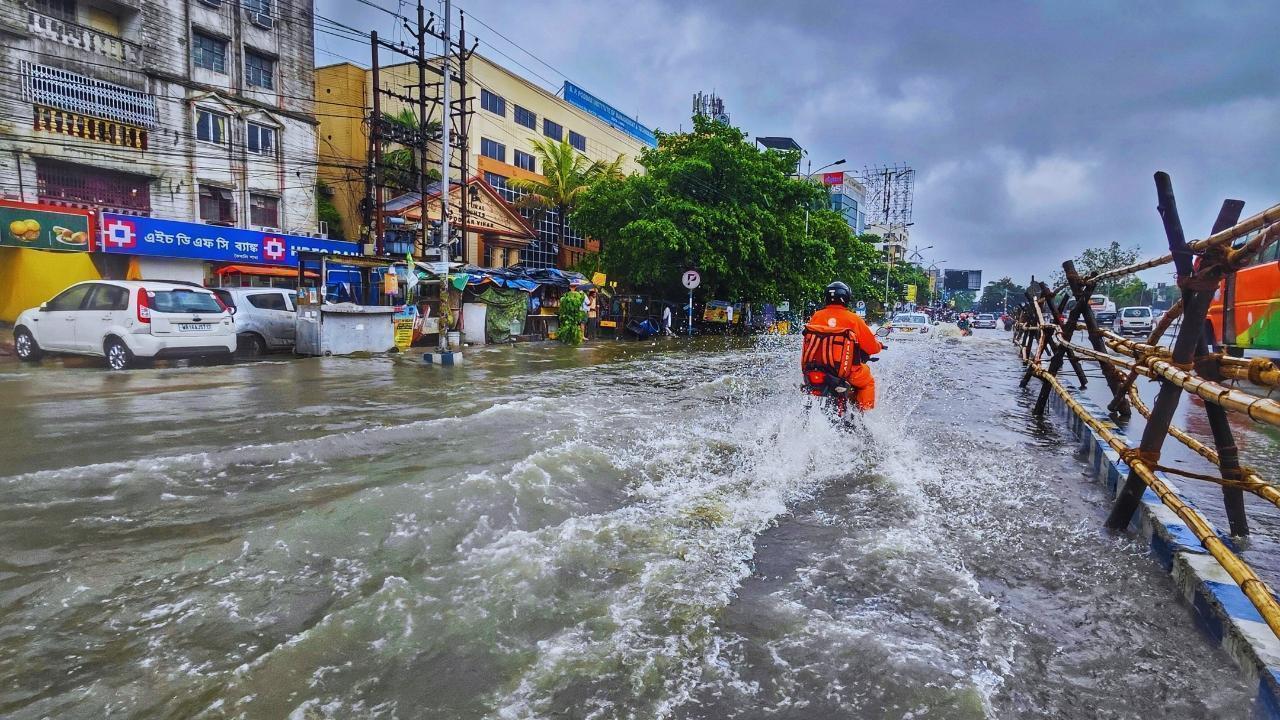
Post by : Anees Nasser
When people think about climate change and rainfall, they often focus on the oceans or global carbon emissions. But the warming trends in the Middle East, one of the world’s hottest and driest regions, are increasingly influencing the South Asian monsoon. This connection is often overlooked but has begun to reshape how scientists, governments, and communities understand rainfall patterns in India, Pakistan, Bangladesh, and beyond.
The monsoon is not only a seasonal weather system; it is a lifeline for over a billion people. Any disruption, whether an intensification or an unpredictable shift, brings enormous consequences for agriculture, food security, and urban life. In 2025, research points to a troubling pattern: as the Middle East heats up faster than many parts of the globe, its atmospheric changes are fueling stronger, less predictable monsoon rains in South Asia.
The Middle East has consistently recorded some of the highest surface temperatures on the planet in recent years. The Arabian Peninsula, Iraq, and parts of Iran frequently experience heatwaves that push beyond 50°C. These extreme conditions are not isolated to the region. They set off a chain reaction that alters the flow of winds, pressure systems, and moisture movement across continents.
The warming air over the Middle East strengthens what climatologists call the "heat low"—a low-pressure zone that develops due to intense heating. This heat low intensifies the pressure gradient between South Asia and surrounding areas, effectively pulling in more moist air from the Arabian Sea and Indian Ocean. The result: heavier and more concentrated rainfall during the monsoon.
For South Asia, the monsoon is both a blessing and a curse. Farmers depend on its arrival for planting rice, wheat, and other staples, while cities rely on it to replenish reservoirs. However, when the rains become too heavy or poorly timed, the same system that sustains life can bring destruction.
The past decade has already shown a worrying trend. India and Bangladesh have experienced more frequent flash floods, while Pakistan’s catastrophic 2022 floods, which displaced millions, remain a grim reminder of how monsoon extremes can devastate entire nations. Scientists now warn that the increasing heat in the Middle East is likely to make such events more common.
Major South Asian cities—Mumbai, Dhaka, Karachi, and Colombo—are on the frontlines of these changes. Rapid urbanization has left many of these cities without adequate drainage systems, meaning even a few hours of heavy rain can flood streets, disrupt transport, and damage property.
When the Middle East’s warming pushes more intense rainfall into these regions, cities already struggling with congestion, pollution, and poor infrastructure face an even greater burden. In Mumbai, for instance, monsoon floods are now an annual ordeal, causing economic losses that run into billions of dollars. Dhaka, with its low-lying geography, faces similar threats that directly impact millions of residents.
Monsoon variability is particularly devastating for farmers. In South Asia, where agriculture is still largely rain-fed, farmers rely on the timing and consistency of rainfall. A stronger but erratic monsoon means crops can be washed away by floods or left to wither if rains retreat prematurely.
In northern India, Punjab and Haryana—the breadbasket states—are experiencing soil degradation due to heavy monsoon downpours, while in Bangladesh, prolonged waterlogging is reducing rice yields. Pakistan, too, struggles with balancing water needs for crops and safeguarding against flood damage. The link between Middle Eastern warming and these outcomes is clear: what happens in one part of the world no longer stays there.
Meteorological studies have increasingly connected Middle Eastern warming with South Asian rainfall intensity. Satellite data and climate models show that the Middle East’s rising land surface temperatures are influencing large-scale circulation patterns like the Walker and Hadley cells, both critical in shaping monsoon behavior.
A study from 2024 highlighted that for every degree of warming in the Middle East, the intensity of South Asian monsoon rainfall could increase by up to 10%. Such findings underline the urgency of addressing emissions not just in South Asia, but globally—including in regions not traditionally linked to rainfall.
The economic implications are immense. Flooding disrupts trade, damages crops, and forces governments to divert resources to relief efforts. Insurance claims rise, infrastructure requires costly repairs, and long-term development plans get derailed.
India has already begun to see losses of billions annually due to unpredictable monsoons, while Bangladesh spends a significant portion of its GDP on flood defense and recovery. Pakistan’s post-flood recovery in 2022 alone required over $16 billion in international aid. If the warming trend in the Middle East continues, these costs are expected to rise sharply.
Beyond economics, there is a profound human toll. Communities living in low-lying areas or near riverbanks are increasingly vulnerable. Rural migrants often move into flood-prone urban neighborhoods, amplifying their exposure to climate risks. Women and children are disproportionately affected, as displacement disrupts education, healthcare, and livelihoods.
In Bangladesh, for example, families in flood-affected regions face cycles of displacement, forcing many to migrate to Dhaka or abroad in search of stability. Pakistan’s flood survivors still live in temporary shelters years after the disaster, showing how long recovery can take.
Governments and regional bodies are beginning to acknowledge this Middle East-South Asia climate connection. India has expanded early warning systems, Bangladesh has invested in cyclone shelters and flood-resilient homes, and Pakistan is seeking climate finance for adaptation.
Yet, these measures address symptoms more than root causes. Mitigating Middle Eastern warming through global emission reductions, renewable energy expansion, and regional cooperation remains critical. Countries in both regions share a vested interest in coordinated climate action—because their fates are now intertwined.
The Middle East is often discussed in terms of geopolitics and energy, not its role in shaping climate in Asia. But as the scientific evidence becomes clearer, policymakers must broaden their perspective. Climate change does not respect borders. The link between desert heat in Saudi Arabia and floods in Bangladesh may seem distant, but it is real—and it demands international recognition.
Only through a global lens can countries prepare adequately. That means considering emissions in the Middle East as part of the broader climate equation that directly impacts food, water, and human security in South Asia.
As South Asia braces for another unpredictable monsoon season, the warming Middle East looms large in the background. The chain of cause and effect demonstrates that climate change is not a local phenomenon but a deeply interconnected global crisis.
For farmers in India, families in Bangladesh, and city dwellers in Karachi or Colombo, the future of the monsoon may no longer rest solely in the Indian Ocean—it also lies in the scorching deserts of the Middle East. The sooner this connection is understood and acted upon, the better chance humanity has of safeguarding one of the world’s most vital weather systems.
This article is based on current climate studies and expert analyses. While care has been taken to ensure accuracy, the evolving nature of climate science means projections may change with new data. Readers are encouraged to consult updated reports for the latest insights.










Curry Powers Warriors to Nail-Biting 109-108 Victory Against Spurs
Stephen Curry's 49 points propel the Warriors to a dramatic 109-108 NBA Cup triumph over the Spurs,

India Advances to Semi-Finals After Thrashing USA in Women’s Blind T20 World Cup
India secured a dominant ten-wicket victory over the USA, advancing to the semi-finals in the Women’

South Africa's Early Advantage as India Struggles on Day Two
On Day Two, India reached 138-4 as South Africa took three early wickets, complicating matters with

Kenta Nishimoto Defeats Lakshya Sen in Japan Masters Semifinal
Lakshya Sen's journey in the Japan Masters ends after losing to Kenta Nishimoto 19-21, 21-14, 12-21

Kenta Nishimoto Defeats Lakshya Sen in Japan Masters Semifinals
Lakshya Sen's run at the Japan Masters concludes with a loss to Kenta Nishimoto in the semifinals, 1

Major IPL Trade: Jadeja Joins Royals as CSK Signs Samson
In a significant IPL trade, CSK has acquired Sanju Samson from Rajasthan Royals in exchange for Ravi